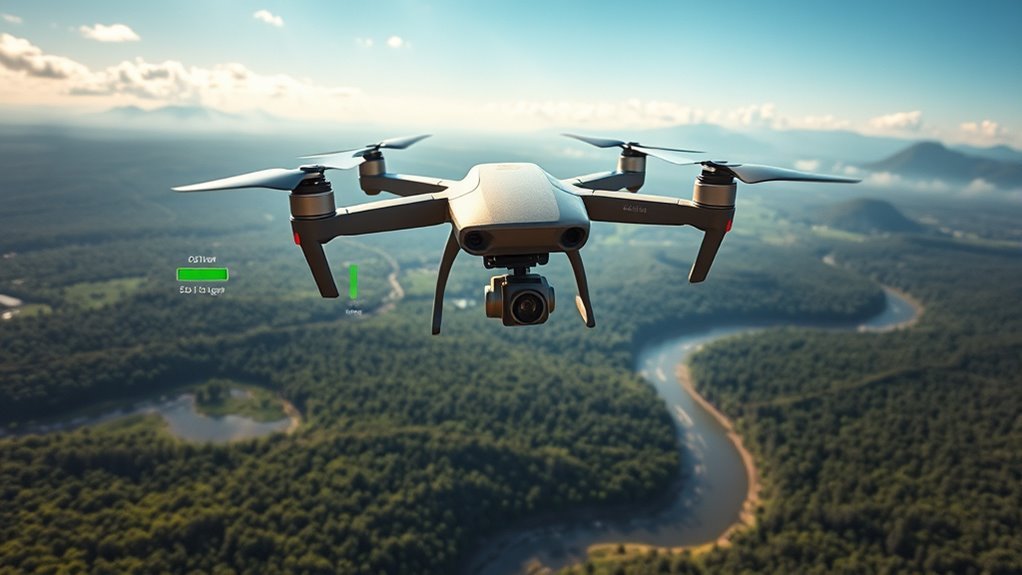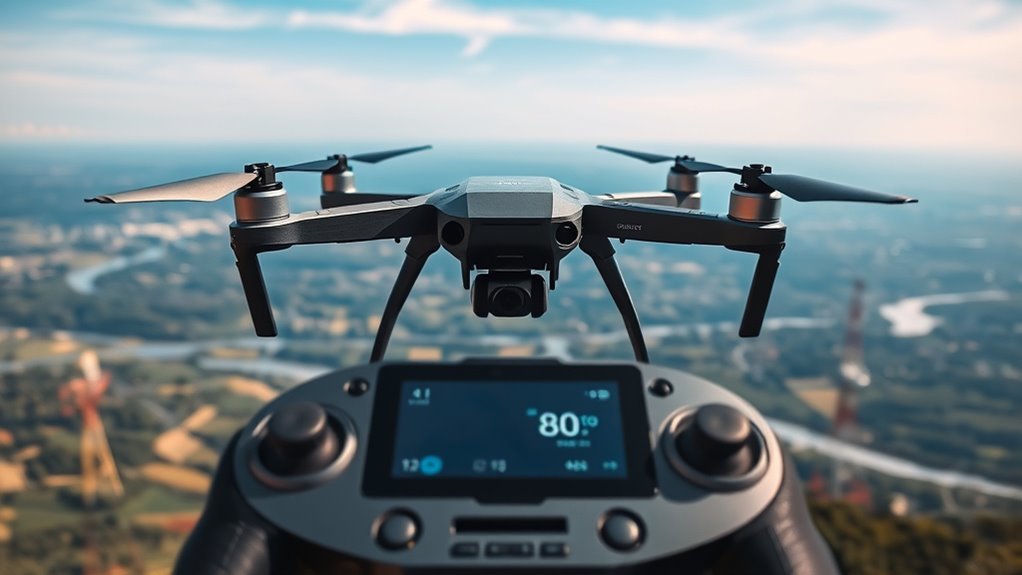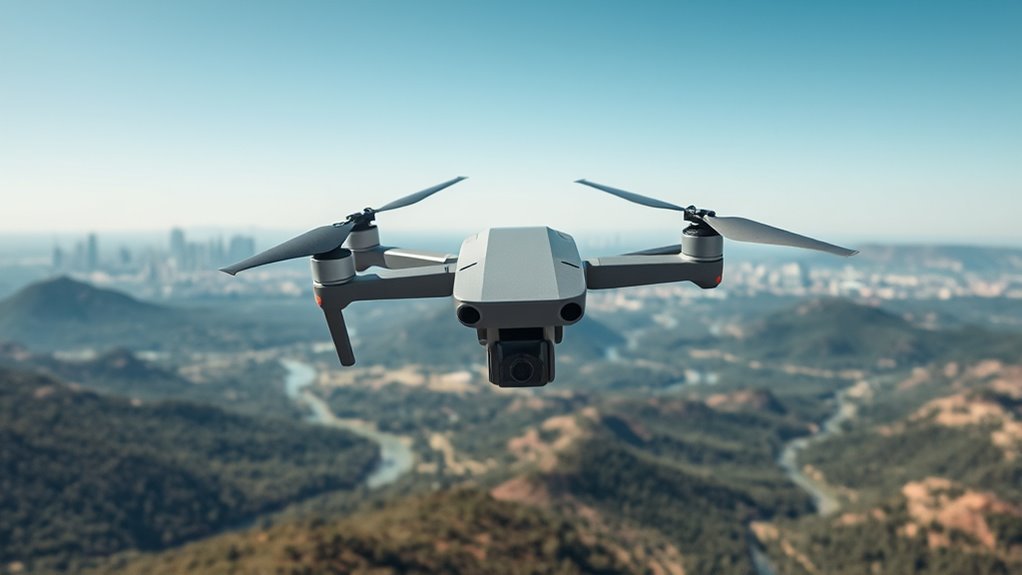The distance your drone can fly depends on its battery capacity, signal range, and weight, including payload. Battery energy density and efficient power management directly impact flight time. Signal strength varies with frequency band, antenna design, and interference. Environmental factors like wind, temperature, and terrain also influence flight range and control stability. Additionally, aerodynamic design and software optimizations can extend reach. Legal restrictions define where you’re allowed to operate. Understanding these factors helps you optimize your drone’s operational limits.
Battery Capacity and Flight Time

Although several factors influence a drone’s range, battery capacity remains the primary determinant of flight time and, consequently, the maximum distance it can cover. When you evaluate battery capacity, you’ll focus on energy density, measured in watt-hours (Wh), as it dictates how much power the battery stores relative to its weight. Battery chemistry plays a critical role here; lithium-polymer (LiPo) batteries, for example, offer superior energy efficiency and power-to-weight ratios compared to older chemistries. This efficiency translates directly to longer flight durations, granting you greater operational freedom. However, optimizing battery capacity must balance weight constraints and power consumption. Understanding these parameters enables you to select or design a drone capable of extended flights, maximizing the distance achievable within the limits of current energy storage technologies.
Signal Range and Controller Technology

When you operate a drone, the signal range and controller technology fundamentally limit how far it can travel while maintaining reliable communication. To maximize your drone’s operational freedom, consider these significant factors:
- Controller Technology: Advanced controllers with digital transmission protocols extend range by reducing latency and boosting signal integrity.
- Antenna Design: Optimized antenna configurations, such as directional or diversity antennas, minimize signal loss and combat signal interference.
- Signal Interference Management: Operating in environments with minimal electromagnetic interference guarantees cleaner communication channels, essential for maintaining control at distance.
Understanding these elements lets you push your drone’s limits confidently, guaranteeing stable command link and real-time data transmission. Remember, your drone’s maximum range isn’t just battery-dependent—it hinges on how effectively your controller and signal systems maintain connection amidst potential interference.
Drone Weight and Payload

Since the total weight of your drone, including its payload, directly impacts its flight duration and maneuverability, understanding how weight affects range is critical. The choice of drone materials influences the frame’s weight, with lightweight composites extending flight time. Payload optimization guarantees you carry only necessary equipment, minimizing excess load and conserving energy. Excess weight demands more thrust, draining batteries faster and limiting range.
| Factor | Impact on Range |
|---|---|
| Drone Materials | Lightweight composites improve efficiency |
| Payload Weight | Heavier loads reduce maximum flight time |
| Payload Optimization | Streamlined payloads enhance endurance |
| Frame Design | Aerodynamic frames lower energy consumption |
Weather Conditions and Wind
You’ll notice that wind speed directly affects your drone’s energy consumption and stability, reducing its effective range. Temperature variations impact battery efficiency, altering flight duration under different thermal conditions. Additionally, humidity levels can influence air density and sensor performance, further affecting your drone’s operational capacity.
Impact of Wind Speed
Although drones are designed to operate efficiently under various conditions, wind speed greatly influences their effective range by altering energy consumption and flight stability. When you pilot a drone, increased wind resistance demands more power to maintain course, directly reducing battery life. Additionally, higher wind speeds challenge flight stability, forcing continuous adjustments that accelerate energy depletion. To optimize range, consider these factors:
- Wind Resistance: Stronger winds increase drag, requiring more thrust and draining batteries faster.
- Flight Stability: Gusts cause erratic movements, compelling stabilization mechanisms to consume extra power.
- Energy Management: Efficient route planning minimizes exposure to adverse winds, preserving battery reserves.
Understanding and adapting to wind speed lets you extend flight duration and maintain control, unleashing greater freedom in drone operation.
Effects of Temperature
When operating drones in varying weather conditions, temperature plays a critical role in battery performance and motor efficiency. Temperature effects directly influence the thermal efficiency of your drone’s power system. In colder environments, battery chemical reactions slow down, reducing capacity and voltage output, which limits your drone’s flight duration and range. Conversely, higher temperatures can increase thermal efficiency but risk overheating components, leading to throttling or shutdowns. Understanding these trade-offs lets you enhance flight plans for maximum freedom. You should monitor ambient temperature closely; operating within the manufacturer’s recommended thermal range guarantees stable power delivery and efficient motor function. By accounting for temperature effects, you maintain peak energy output and avoid unexpected performance drops, ultimately extending how far your drone can reliably go.
Influence of Humidity Levels
Temperature impacts your drone’s power system, but humidity levels also play a significant role in flight performance and range. Understanding humidity effects is essential because moisture impact can alter air density and battery efficiency, directly influencing how far your drone can travel. Here’s what you need to evaluate:
- Air Density Reduction: High humidity decreases air density, reducing lift and forcing your motors to work harder, which drains the battery faster.
- Battery Performance: Moisture can affect the chemical reactions within lithium-polymer batteries, lowering voltage output and shortening flight time.
- Sensor Accuracy: Elevated humidity may interfere with onboard sensors, compromising navigation and stability, which can indirectly limit range.
Terrain and Obstacles
Several key terrain features and obstacles directly influence your drone’s effective range by affecting signal strength and flight stability. Different terrain types, such as urban environments dense with man-made structures or rural areas characterized by natural barriers, impose unique challenges. Elevation changes and varied landscape features demand precise obstacle navigation and flight path planning to maintain control and avoid signal loss. Urban settings often require sophisticated obstacle avoidance techniques due to dense buildings, while rural zones pose risks from trees and hills disrupting line-of-sight communication. Understanding these factors is vital for maximizing your drone’s operational freedom. By adapting your flight plan to terrain complexities, you can mitigate interruptions caused by obstructions, thereby extending your drone’s reliable range and ensuring a safer, more efficient flight experience.
Drone Design and Aerodynamics
Although terrain and obstacles play a crucial role, the intrinsic design and aerodynamic efficiency of your drone fundamentally dictate its range capabilities. Optimizing these factors guarantees you maximize flight freedom without frequent returns.
Key considerations include:
- Drone Materials: Lightweight, durable composites reduce overall weight, directly enhancing battery efficiency and flight duration.
- Aerodynamic Shapes: Streamlined designs minimize drag forces, allowing your drone to slice through air with less resistance, conserving energy.
- Structural Configuration: The arrangement of components influences airflow and stability, impacting how efficiently your drone maintains speed and altitude.
Frequency Bands and Interference
When you operate your drone, the choice of frequency bands directly affects communication range and signal stability. Commonly, drones utilize 2.4 GHz or 5.8 GHz bands, each with distinct propagation characteristics. Lower frequencies typically offer longer range and better penetration through obstacles but are more prone to frequency interference due to crowded usage. Higher frequencies provide greater bandwidth but suffer more from signal degradation over distance and through physical barriers. Frequency interference from Wi-Fi networks, Bluetooth devices, or other drones can cause intermittent signal loss or control lag, limiting your drone’s effective range. Selecting a less congested frequency band or employing frequency hopping techniques can mitigate interference, enhancing signal integrity. Ultimately, understanding frequency dynamics allows you to maximize your drone’s operational freedom while minimizing communication disruptions.
Software and Flight Modes
You’ll find that your drone’s firmware directly influences signal stability and power management, both critical for maximizing range. Advanced autonomous flight modes optimize navigation efficiency, reducing unnecessary power consumption during extended missions. Understanding how software algorithms control these aspects is essential for enhancing your drone’s operational distance.
Firmware Impact on Range
Since firmware governs the drone’s control algorithms and communication protocols, it directly influences how efficiently the drone manages power and signal transmission, thereby affecting its operational range. When you guarantee your drone’s firmware is up to date, you benefit from performance optimization that can extend flight time and communication stability. Firmware updates often refine:
- Power management protocols—reducing energy waste and extending battery life.
- Signal modulation techniques—enhancing transmission reliability over longer distances.
- Flight mode algorithms—optimizing responsiveness and control precision to conserve energy.
Autonomous Flight Capabilities
Although autonomous flight capabilities rely heavily on sophisticated software and varied flight modes, their impact on drone range is often underestimated. When you leverage autonomous navigation, your drone can enhance its path, reducing energy consumption and extending flight duration. Efficient flight planning algorithms calculate the most direct and energy-efficient routes, minimizing unnecessary movements. Sensor integration plays an essential role by providing real-time data for obstacle avoidance, allowing the drone to maintain peak speeds without abrupt stops or detours that waste battery life. By relying on these advanced systems, you gain greater operational freedom, pushing your drone further while maintaining safety and precision. Ultimately, autonomous flight capabilities don’t just support navigation—they actively enhance your drone’s effective range through intelligent, adaptive control.
Legal Restrictions and No-Fly Zones
When operating a drone, understanding legal restrictions and no-fly zones is essential because they directly limit where and how far you can fly. No fly regulations are designed to protect sensitive areas and manage airspace safety, so ignoring them can result in penalties or worse. You need to analyze airspace classifications, which define permissible drone operations based on altitude, location, and proximity to airports or critical infrastructure. To maximize your drone’s range without legal issues, consider these factors:
- Identify restricted zones such as airports, military bases, and national parks where drone flights are prohibited.
- Review temporary flight restrictions (TFRs) that may be active for events or emergencies.
- Understand the specific airspace class you’re operating in to comply with altitude limits and permission requirements.
Respecting these constraints guarantees your drone flights stay legal and safe.

